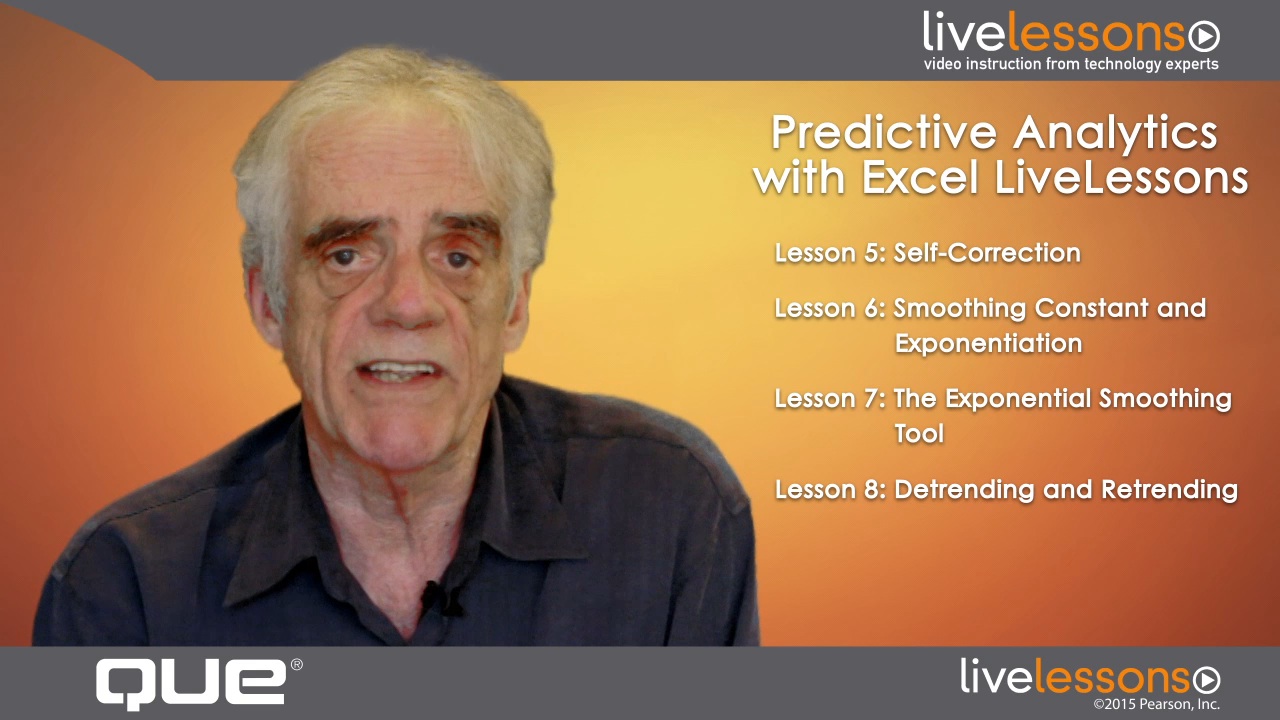Predictive Analytics with Excel LiveLessons (Video Training), Downloadable Video: Exponential Smoothing and Autoregression
- By Conrad Carlberg
- Published Sep 9, 2014 by Que. Part of the LiveLessons series.
Downloadable Video
- Sorry, this book is no longer in print.
- About this video
Accessible from your Account page after purchase. Requires the free QuickTime Player software.
Videos can be viewed on: Windows 8, Windows XP, Vista, 7, and all versions of Macintosh OS X including the iPad, and other platforms that support the industry standard h.264 video codec.
Register your product to gain access to bonus material or receive a coupon.
Description
- Copyright 2015
- Edition: 1st
- Downloadable Video
- ISBN-10: 0-7897-5371-5
- ISBN-13: 978-0-7897-5371-7
3 Hours of Video Instruction
Overview
In just three hours, discover how to create accurate forecasts and predictions with Microsoft Excel's powerful predictive analytics tools!
Description
Moneyball made predictive analytics famous: now, you can put it to work! In just three hours of expert video, Conrad Carlberg will teach you all the core skills you need to create accurate predictions of your own with Microsoft Excel–hands-on! Learn how to use Excel to design and run the two most basic analyses used in quantitative forecasting: smoothing and regression. Explore the self-correcting nature of exponential smoothing, discover how to use autoregression to create effective forecasts, and get comfortable using Excel's powerful Data Analysis and Solver add-ins. Understand trends in time series, and master differencing, the most important technique for dealing with them. Finally, learn about ACFs and PACFs, and uncover their patterns to identify the best ways to forecast any given time series. These hands-on videos are accompanied by Excel workbooks containing all sample data and analyses: workbooks you can easily replicate and adapt for your own needs!
About the Instructor
Conrad Carlberg is a multiple recipient of Microsoft's Most Valuable Professional (MVP) award for Microsoft Excel. He has written twelve books about quantitative analysis with Excel, including Predictive Analytics: Microsoft® Excel. As President of Network Control Systems, Inc., he leads the development of quality control and forecasting tools for the health industry. Carlberg holds a Ph.D. in statistics from the University of Colorado, and has 25 years' experience applying advanced analytical techniques.
Skill Level
- All Levels
- Beginner
- Intermediate
- Advanced
What You Will Learn
- The essentials and basic terminology of predictive analysis
- How to use Excel's core predictive analysis tools, including the Data Analysis and Solver add-ins
- How to perform quantitative analyses using smoothing and regression
- How to create effective forecasts using autoregression
- How trends in time series work, and how to handle the challenges they create
- How to choose the best approach to forecast any time series
Who Should Take This Course
- Every businessperson, scientist, analyst, and student who wants to master the essentials of predictive analytics
Course Requirements
- Basic experience with Microsoft Excel
- Basic knowledge of simple statistical analysis techniques
Table of Contents
Introduction
Part 1: Moving Averages
Lesson 1: Length of Moving Averages
Lesson 2: Length's Effect on Level
Lesson 3: Weighted and Unweighted Moving Averages
Lesson 4: The Moving Average Tool and Trendlines
Part 2: Smoothing
Lesson 5: Self-Correction
Lesson 6: Smoothing Constant and Exponentiation
Lesson 7: The Exponential Smoothing Tool
Lesson 8: Detrending and Retrendng
Lesson 9: Choosing the Smoothing Constant
Part 3: Regression
Lesson 10: Simple, two-variable regression
Lesson 11: TREND() and LINEST()
Lesson 12: Problems Using Time as a Predictor
Part 4: Autoregression
Lesson 13: Simple single lag autoregression
Lesson 14: Correlograms and moving average time series
Summary
About LiveLessons Video Training
LiveLessons Video Training series publishes hundreds of hands-on, expert-led video tutorials covering a wide selection of technology topics designed to teach you the skills you need to succeed. This professional and personal technology video series features world-leading author instructors published by your trusted technology brands: Addison-Wesley, Cisco Press, IBM Press, Pearson IT Certification, Prentice Hall, Sams, and Que. Topics include: IT Certification, Programming, Web Development, Mobile Development, Home and Office Technologies, Business and Management, and more. View all LiveLessons on InformIT at: http://www.informit.com/livelessons
Sample Content
Table of Contents
Introduction
Part 1: Moving Averages
Lesson 1: Length of Moving Averages
Lesson 2: Length's Effect on Level
Lesson 3: Weighted and Unweighted Moving Averages
Lesson 4: The Moving Average Tool and Trendlines
Part 2: Smoothing
Lesson 5: Self-Correction
Lesson 6: Smoothing Constant and Exponentiation
Lesson 7: The Exponential Smoothing Tool
Lesson 8: Detrending and Retrendng
Lesson 9: Choosing the Smoothing Constant
Part 3: Regression
Lesson 10: Simple, two-variable regression
Lesson 11: TREND() and LINEST()
Lesson 12: Problems Using Time as a Predictor
Part 4: Autoregression
Lesson 13: Simple single lag autoregression
Lesson 14: Correlograms and moving average time series
Summary
More Information

